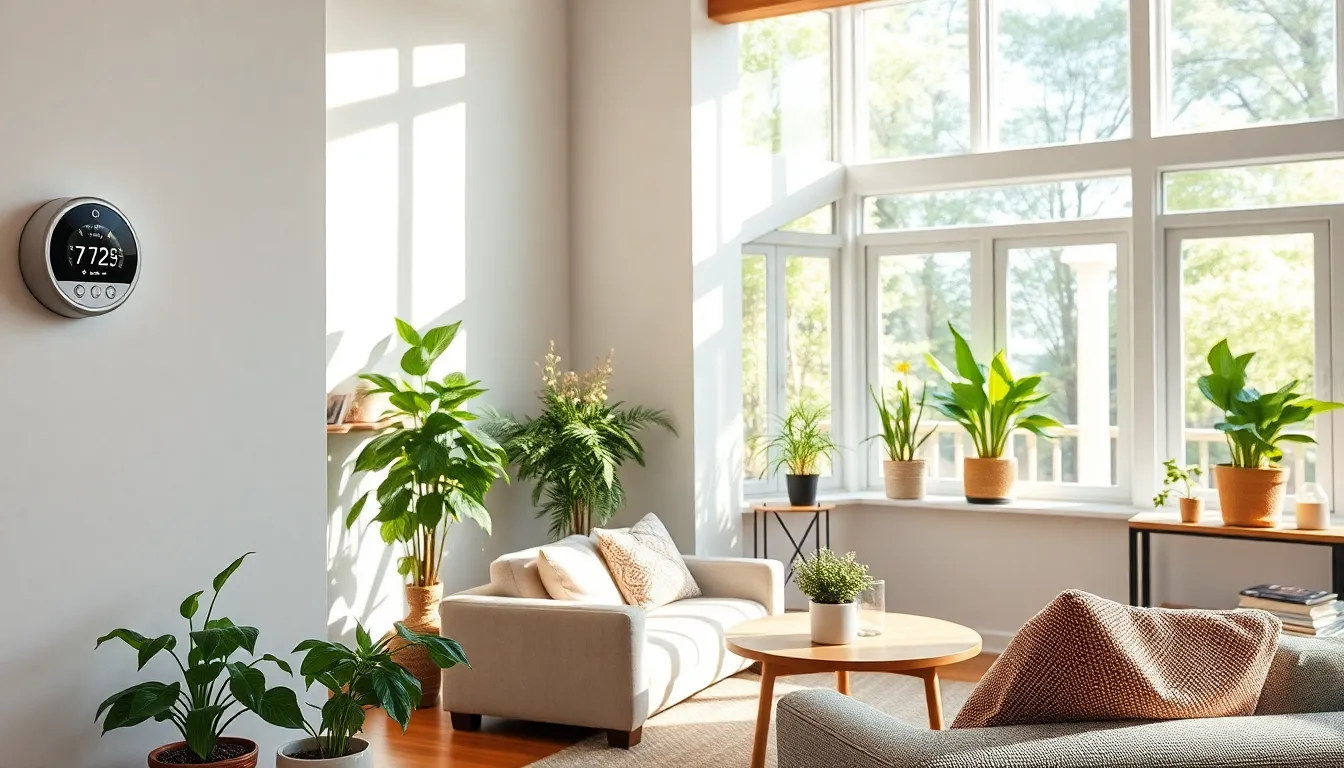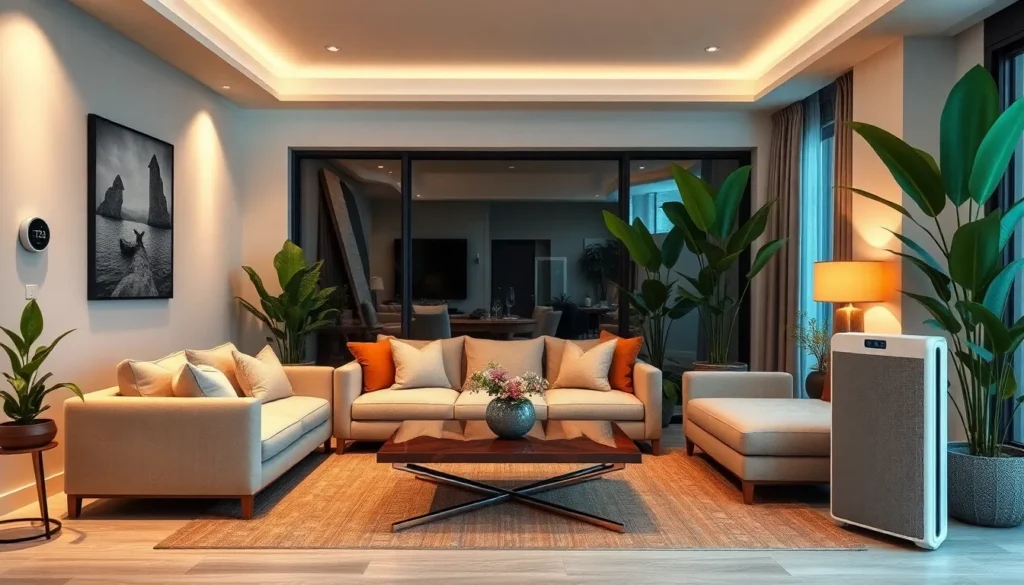Imagine walking into your home and feeling like you’ve just stepped into a five-star resort. With home environment control, that dream can become a reality. From adjusting the temperature to optimizing air quality, it’s all about creating a space that feels just right. Who wouldn’t want to kick back in a perfectly cozy living room while the world outside battles the elements?
Table of Contents
ToggleOverview Of Home Environment Control
Home environment control involves the management of temperature, humidity, air quality, and lighting within a living space. This control enhances comfort and well-being, making homes more enjoyable for residents. Adjusting these elements leads to better indoor air quality, efficient energy use, and overall satisfaction.
Temperature regulation plays a crucial role in comfort. Smart thermostats can automatically adjust temperatures based on preferences and external weather conditions. Homeowners can save energy and costs by optimizing heating and cooling systems.
Humidity control also contributes significantly to indoor comfort. Maintaining optimal humidity levels, usually between 30% and 50%, prevents mold growth and supports respiratory health. Dehumidifiers and humidifiers are effective tools for achieving this balance.
Air quality management enhances living conditions. Air purifiers filter out pollutants and allergens, significantly improving health and comfort. Regular maintenance of HVAC systems ensures clean air circulation throughout the home.
Lighting control impacts mood and productivity. Smart lighting systems allow for adjustment of brightness and color temperature based on activities and times of day. Energy-efficient LED bulbs further contribute to lower energy expenses while providing quality illumination.
Integrated systems offer convenience and automation. Smart home technology brings together various aspects of environment control, allowing users to manage settings through apps or voice commands. This interconnectedness streamlines daily routines, providing comfort with minimal effort.
Overall, effective home environment control improves the quality of life for residents. Implementing these strategies leads to a healthier, more inviting space that positively influences daily living.
Importance Of Home Environment Control

Managing a home’s environment significantly impacts comfort and quality of life. Effective control enhances both health and efficiency, creating a sustainable living space.
Benefits For Health And Wellbeing
Controlling indoor elements directly influences overall health. Quality air reduces allergens, leading to fewer respiratory issues. A stable temperature prevents overheating or excessive cold, promoting better sleep patterns. Proper humidity limits mold growth, safeguarding respiratory systems. Mood improvement results from adequate lighting, boosting productivity and emotional well-being. Enhanced comfort levels contribute to reduced stress and increased relaxation.
Impact On Energy Efficiency
Home environment control enhances energy efficiency through precise temperature management. Smart thermostats optimize energy use, lowering bills while maintaining comfort levels. Proper insulation prevents heat loss, ensuring systems work effectively. Energy-efficient lighting, such as LEDs, reduces electricity consumption while providing ample illumination. Regular maintenance of HVAC systems supports optimal performance, minimizing energy waste. Comprehensive management of humidity and air quality decreases reliance on heating and cooling systems, resulting in further energy savings.
Technologies For Home Environment Control
Home environment control leverages various technologies to maintain comfort and efficiency. These innovations enhance living spaces, ensuring a tranquil and pleasant atmosphere.
Smart Thermostats
Smart thermostats automate temperature regulation in homes. They learn preferences, optimizing heating and cooling based on daily routines. With remote access, users adjust settings from smartphones. Energy consumption decreases significantly, often reducing bills by 10-20%. Integration with other smart devices creates a cohesive home ecosystem, improving overall efficiency.
Air Quality Monitors
Air quality monitors provide real-time data on indoor pollutants. These devices measure levels of volatile organic compounds, particulate matter, and humidity. When poor air quality is detected, alerts prompt immediate action, maintaining a healthy environment. Users can track changes over time to identify patterns and make necessary adjustments. Enhancing air quality supports respiratory health and overall well-being.
Home Automation Systems
Home automation systems integrate multiple devices into a single platform. These systems allow seamless control of lighting, temperature, and security. Users program schedules or utilize voice commands for convenience. Automation enhances energy efficiency by optimizing operation during peak hours. The ability to monitor and manage home elements remotely adds layers of comfort and security.
Strategies For Effective Home Environment Control
Implementing effective home environment control strategies enhances comfort and well-being. Several key areas warrant attention: temperature regulation, humidity control, and indoor air quality management.
Temperature Regulation
Temperature regulation plays a critical role in maintaining a comfortable home. Smart thermostats adjust heating and cooling based on user preferences. Consistently maintaining temperatures between 68°F and 72°F promotes optimal comfort and sleep quality. Zoning systems allow different areas to be heated or cooled individually, minimizing energy waste. Programmable settings in smart systems can learn patterns, ensuring efficiency and convenience.
Humidity Control
Humidity control significantly impacts overall health and comfort. Maintaining indoor humidity levels between 30% and 50% can prevent mold growth and respiratory issues. Dehumidifiers remove excess moisture from the air, effectively reducing the risk of allergens. Additionally, humidifiers add moisture in dry seasons, supporting skin and respiratory health. Regularly monitoring indoor humidity levels aids in adjusting conditions efficiently.
Indoor Air Quality Management
Indoor air quality management ensures a healthy living environment. Air purifiers with HEPA filters capture dust, pollen, and other allergens effectively. Ventilation systems should include carbon dioxide monitoring features to maintain optimal air quality. Routine maintenance of HVAC systems helps eliminate pollutants and distribute clean air. Incorporating houseplants can also improve air quality naturally, promoting a fresher atmosphere.
Mastering home environment control not only enhances comfort but also significantly improves overall well-being. By optimizing temperature, humidity, and air quality, individuals create a sanctuary that promotes relaxation and productivity. The integration of smart technologies simplifies this process, making it easier to maintain a healthy living space.
Investing in these systems leads to lower energy costs and a more sustainable home. Ultimately, a well-controlled home environment fosters a sense of peace and enhances daily life, ensuring that every moment spent indoors is enjoyable and rejuvenating.





